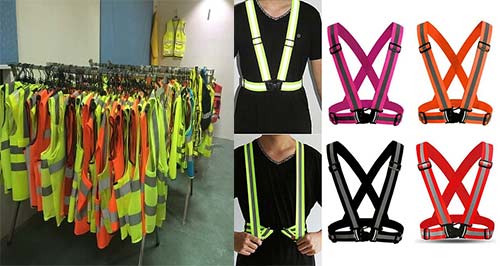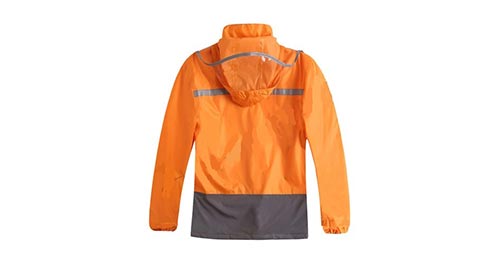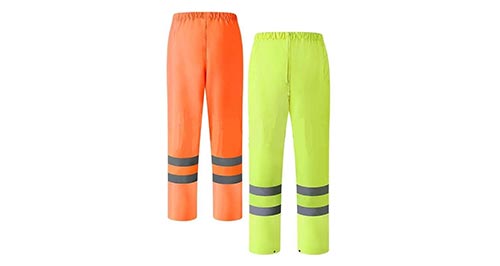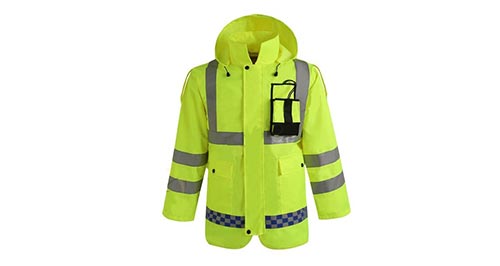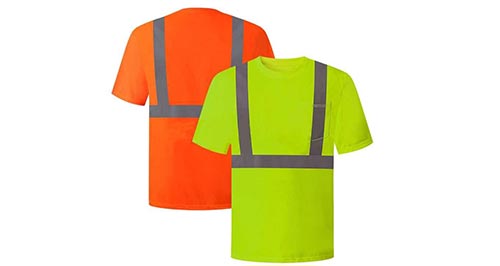SAFETY CLOTHING
XW Reflective is an experienced reflective material supplier in China, with our own reflective materials products factory. Because of this unique raw material advantage, XW Reflective decides to supply the reflective clothing to the market at such a competitive price.
XW Reflective has our own raw reflective material manufacturer, can get low-cost reflective material and easy to control the raw material during the process of reflective material tapes manufacturing, the whole production from raw reflective materials to final reflective clothing, XW Reflective promises the quality of every step, and you can track every reflective vest from raw material to final safety vest products, totally shows to our customers.
XW Reflective provides safety vests, Hi-vis jackets, safety pants, safety raincoats, safety shirts & sweatshirts, and safety coveralls at wholesale price, if you are looking for a good price & quality reflective clothing, or you want to have a customized design for reflective clothing in a big production, you are welcome to contact us for more details online or visit our factory for more information.
Reflective Clothing FAQ Guide
The workforce in any organization is marred with tons of regulations regarding safety. The outdoor clothing usually plays a considerable role in ensuring that working personnel are well-equipped for the task.
Aside from the regular construction works and firefighters, clothing with aerodynamic reflection properties is used by sportsmen in their gaming activities to enhance visibility.
One major perk of these reflective garments is that they can withstand extreme weather conditions. They are specifically designed to operate under conditions of extreme temperature or rain.
Every year, several employees or motorists die in accidents involving moving vehicles or objects in their construction workplaces because their presence was not positively identified. At the same time, many accidents emanate from poor visibility of people moving along the roads, thus increasing the risk of them being hit by vehicles or moving objects.
With the ever-increasing safety hazards, the need for reflective clothing is ever on the rise to enhance the visibility and presence of people working in construction sites, motorists and passers-by.
Also known as high-visibility warning clothing, reflective clothing is meant to signal users’ presence in various working environments, especially in places where their safety and health are at risk.
This kind of signaling is essential, whether at night or during the day, to offset any likelihood of workers colliding with vehicles or moving objects.
In most cases, these types of risks occur in industrial facilities and various kinds of transport, and it also applies to drivers of huge vehicles. Besides, the loading and offloading of heavy-duty goods pose a significant threat to the workers working in that particular site.
In fire brigades and medical rescue teams, reflective clothing is essential in ensuring that the workers do not get involved in accidents. Whenever a fireman is extinguishing fire and gets caught up in some form of enclosure, the reflective clothing will come in handy in propagating their visibility.
This also applies in non-professional uses such as pedestrians crossing the roads, such as pedestrians and cyclists who cycle to work or exercise. While riding along a road with insufficient lit streets or well-labeled walkways, the cyclists may be hit by vehicles due to poor visibility.
It is essential to note that reflective clothing minimizes the risk of getting involved in an accident but doesn’t eliminate it.
While it optimizes the user’s visibility and significantly lowers the risk of getting involved in an accident, it does not guarantee complete protection from accidents.
Such risks emanating from poor visibility are common in winter and autumn when people wear clothes with relatively dark colors to minimize heat loss. If you like cycling during these periods, wearing reflective clothing will enhance your visibility and reduce the chances of getting involved in accidents.
The surface of reflective clothing is rough and not smooth.
The microscopic particles embedded on the surface work by scattering light in every direction.
The reflective clothing’s basic design is having a yellow base fabric and micro-glass beads, prisms or reflective tape attached to the base fabric’s surface. Additional technologies ranging from coatings, composites, and additional processing methods like hot pressing are crucial to increasing the reflective coefficient.
When light falls on the reflective clothing, the glass beads or prisms collect the light, focus it and transmit it back along the same incoming path.
The concept behind the working of a piece of reflective clothing is that when light is focused on it, the reflective fabric will either scatter the light or reflect it along the same path. This is because the retro-reflection principle enables it to reflect light along the same path while the other method is scattered reflection.
If a car driver does not see reflective clothing more than 300 meters away, the light from the headlight will hit the person wearing the piece of reflective clothing and reflect the light to the driver.
Keep in mind that the surface of the reflective clothing is rough, so some of the light from the reflection might be lost along the way. However, the great news is that majority of the rays will reach the driver and prevent an imminent accident.
Reflective clothing has a myriad of uses, and its functionalities are virtually endless.
Personal safety in clothing is not a new concept, but the relatively new technology that comes with reflective clothing and comfort makes its functionalities virtually endless.
Since the 20th century, reflective clothing has been used for the purposes listed below.
- Motorists and cyclists
- Road construction workers
- Construction safety
- Railway construction safety
- Fire fighting
- Pedestrians
When working in an environment like a mine, railway or road construction site, the working environment can be messy.
For this reason, reflective clothing can have a lot of dirt accumulating on it, which makes it necessary to wash it frequently. Aside from having a limited number of washing cycles for the reflective clothing, washing it the wrong way can significantly reduce the reflective material’s lifespan.
Remember that reflective clothing is different from ordinary garments, and washing it the right way will keep it longer and more effective. While there are general instructions for cleaning the reflective material, make sure to go through the specific instructions highlighted by your manufacturer.
If you opt to go for machine wash, wash with cold water and ensure that the cycle is delicate. At the same time, you can use a mild detergent but avoid using bleach or a fabric softener.
Wash the reflective material with like colors and avoid mixing it with rough garments like jeans as the microscopic glass beads or prisms can be worn off by the rough texture.
At all times, line dry the reflective material since machine drying can damage the reflective heat transfer film.
Overall, the most critical step here is to go through the manual carefully, so you have a tailored set of instructions for your specific reflective clothing.
There are several compliance requirements for unused reflective clothing, but they often don’t cover the clothing’s compliance once it has been worn.
Nonetheless, it’s essential to ascertain the quality of the reflective clothing before using it to ensure you don’t compromise its performance and jeopardize your safety.
Several reflective clothings have an upper threshold life cycle of 25 washes unless explicitly stated otherwise in the packaging. In other words, over-washing the garment above this limit will lead to a loss of its compliance and increase the likelihood of an accident.
At the same time, not washing it regularly will make stains and dirt accumulate on its surface and reduce the item’s visibility.
With this approach, you won’t be washing the garments frequently, and ensure you replace the reflective clothing every three months.
The reflective clothing is categorized into three main classes depending on the level of visibility.
When you’re selecting the reflective garment, the risks associated with your work nature will determine the amount of reflective material and quality of the micro glass beads attached to the fluorescent material.
At a glance, the first class, class 1, comprises the lowest visibility of reflective clothing. This category includes high visibility trousers and is commonly worn differently from other reflective clothing garments.
The next class, class 2, falls mid-range between class 1 and class 3. The items falling into this category include the high visibility sleeveless vests. They are commonly worn by cyclists engaging in sporting activities.
Class 3 is the top category of visibility, and the items falling into this category are safety jackets and sleeved high visibility vests.
Several new modifications have created an enormous distinction between the different types of risk situations to determine the level of protection they can provide and the durability.
Generally, the durability requirements depend on which part of the body the reflective clothing covers. From the arms to the legs and torso, the reflective material’s design and durability are meant to enhance its longevity.
Durability qualities of reflective clothing include tensile strength, burst strength. Surprisingly, these durability qualities have been reduced to cater for an increase in color fastness.
However, the great news is that reflective clothing can withstand extreme heat, water, and dust exposure. As long as you don’t exceed the washing cycle threshold, the material will remain incredibly durable in the course of its life cycle.
The preliminary step to check before wearing is to ensure the reflective clothing is not dirty.
Wearing a dirty garment will cover the micro glass beads or prisms and affect the reflective garment’s performance.
At the same time, check to ensure the reflective surface is outside the garment and that the stripes are on the outside surface to ensure it remains in operation.
While the reflective clothing has a high water resistance value, it’s not advisable to wear it while still wet. If the time between the washing and next usage isn’t sufficient to dry to completion, make sure to get another reflective garment to enable it to have enough drying time.
Besides, your reflective garment should be fastened at all times. Wearing clothing that hasn’t been sufficiently secured against your body will severely jeopardize its functionality.
While reflective clothing has high durability levels, it’s essential to adhere to the storage instructions to enhance performance.
Keep it in the original packaging and away from light and humidity. Besides, ensure that you don’t expose it to too high temperatures as that could jeopardize the functionality of the glass beads and prismatic reflective components.
One major perk of reflective garments is that you can tailor them to suit your specific design requirements.
Besides having a custom style created for you, it supports printing, logo printing, and samples available for you to choose from.
With over ten years’ manufacturing experience, our designers have gained top-notch skills in coming up with the highest quality standards of manufacturing reflective clothing.
Aside from commanding a colossal client base across the globe, Xing Wei has specialized in creating top-quality reflecting clothing products.
The entire process has been refined from the production and process to the sales team and shipping to meet the highest quality standards.
To clear any doubts, contact us today to get tailored information on your reflective clothing needs.
When light falls on the reflective clothing, it gets reflected along the same path.
Whether its’s nighttime or during the day, the reflective tape, glass prisms and beads embedded in the fabric reflect light along the same path.
The only disparity is how the garment appears at different times.
The garment’s visibility during the day is yellow, and the reflective tape appears silver-grey when light shines on it. At the same time, the material appears green during the night, and the reflective tape appears white.
How does reflective clothing enhance your safety?
When you walk at night, you are invisible to drivers. This makes you four times more vulnerable to being hit by a vehicle at night.
However, with reflective clothing, you’ll remain visible, and the chances of being hit by a car will dramatically reduce.
Why do cyclists wear reflective clothing?
Reflective clothing is essential for cyclists to enable them to protect themselves from other motorists.
Often, cyclists use fluorescent colors to make them glow better and enhance visibility during the day and night.
What environmental considerations should I make when cleaning reflective clothing?
The cleaning temperature of the material should be 40 degrees Celsius. At the same time, make sure to maintain the iron temperature at 110 degrees Celsius when removing the creases.
Can I use bleach when washing the reflective clothing?
No, do not use bleach. Solvent contamination, dry cleaning and machine drying will damage the material’s fabric and reduce its longevity.
